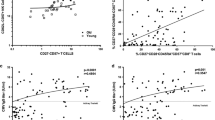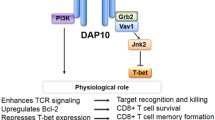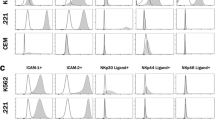Summary
This review reports the characteristics of the human surface molecule CD38, a structure not linked to a definite line and predominantly expressed in early and activated phenotypes. The CD38 molecule consists of a single chain of 46 kDa, spanning the membrane and with the carboxyl terminus located in the extracellular compartment. The CD38 molecule is also involved in the transduction of activation and proliferation signals, which are line unrestricted. The gene coding for the CD38 antigen has been cloned and used for the construction of simian and mouse transfectants expressing the human molecule. These cell models are used for the analysis of several unanswered issues, mainly concerning the in vivo function of CD38, the existence of a natural ligand and of polymorphism in the population.
Similar content being viewed by others
References
Alessio M, Roggero S, Funaro A, DeMonte LB, Peruzzi L, Geuna M, Malavasi F, CD38 molecule: structural and biochemical analysis on human T lymphocytes, thymocytes ad plasma cells. J Immunol 145:878, 1990
Bushkin Y, Chorney MJ, Diamante E, Lane C, Fu SM, Wang CY, Biochemical characterization of a P43,12 complex: comparison with human and murine Class I molecules. Mol Immunol 22:695, 1985
Calabi F, Bradbury A, The CD1 system. A review. Tissue Antigens 37:1, 1991
Claesson L, Larhammar D, Rask L, Peterson PA, A cDNA clone for human invariant j chain of Class II histocompatibility antigens and its implication for the protein structure. Proc Natl Acad Sci USA 80:7395, 1983
Clark EA, Ledbetter JA, Amplification of the immune response by agonistic antibodies. Immunol Today 7:267, 1986
Cotner T, Mashimo H, Kung PC, Goldstein G, Strominger JL, Human T cell surface antigens bearing a structural relationship to HLA antigens. Proc Natl Acad Sci USA 78:3858, 1981
DeMonte LB, Nisticò P, Tecce R, Dellabona P, Momo M, Anichini A, Mariani M, Natali PG, Malavasi F, Gene transfer by retrovirus-derived shuttle vectors in the generation of murine bispecific monoclonal antibodies. Proc Natl Acad Sci USA 87:2941, 1990
Ehler S, Smith KA, Differentiation of T cell lymphokines gene expression: the in vitro acquisition of T cell memory. J Exp Med 173:25, 1991
Funaro A, Spagnoli GC, Ausiello CM, Alessio M, Roggero S, Delia D, Zaccolo M, Malavasi, F, Involvement of the multilineage CD38 molecule in a unique pathway of cell activation and proliferation. J Immunol 145:2390, 1990
Gessani S, McCandless P, Baglioni C, The glucocorticoid dexamethasone inhibits synthesis of interferon by decreasing the level, of its mRNA. J Biol Chem 283:7454, 1988
Jackson DG, Bell JI, Isolation of a cDNA encoding the human CD38 (T10) molecule a cell surface glycoprotein with an unusual discontinuous pattern of expression during lymphocyte differentiation. J Immunol 144:2811, 1990
Katz F, Povey S, Parkar M, Schneider C, Sutherland R, Stanley K, Solomon E, Greaves M, Chromosome assignment of monoclonal antibody-defined determinants on human leukemic cells. Eur J Immunol 13:1008, 1983.
Ma DDF, Sylwestrowicz, Granger S, Massaia M, Franks R, Janossy G, Hoffbrand AV, Distribution of terminal deoxynucleotidyl transferase and purine degrative and synthetic enzymes in subpopulations of human thymocytes. J Immunol 129:1430, 1982
Malavasi F, Caligaris-Cappio F, Dellabona P Ricchiardi P, Carbonara AO, Characterization of a murine monoclonal antibody specific for human early lymphohemopoietic cells. Hum Immunol 9:9, 1984
Reinherz EL, Kung PC, Goldstein G, Levey RH, Schlossman SF, Discrete stages of human intrathymic differentiation: analysis of normal thymocytes and leukemic lymphoblasts on T-cell lineage. Proc Natl Acad Sci USA 77:1588 1980
Schnizlein-Bick CT, Magier MR, Jones RB, Fife KH, Katz BP Walker EB, Differences among mononuclear cell subpopulations in HIV seropositive or seronegative homosexual and heterosexual men as determined by four-color flow cytometry. J AIDS 3:747, 1990
Stamenkovic I, Staunton J, Seed B, Molecular cloning of CD38. In: Knapp W, Dörken B, Gilks WR, Rieber EP, Schmidt RE, Stein H, Kr von dem Borne AEG (eds) Leukocyte typing. IV. Oxford University Press, Oxford, p 87, 1989
Terhorst C, Agthoven A van, Le Clair, K, Snow P, Reinherz EL, Schlossman SF, Biochemical studies of the human thymocyte cell-surface antigens T6, T9 and T10. Cell 23:771, 1981
Author information
Authors and Affiliations
Rights and permissions
About this article
Cite this article
Malavasi, F., Funaro, A., Alessio, M. et al. CD38: A multi-lineage cell activation molecule with a split personality. Int J Clin Lab Res 22, 73–80 (1992). https://doi.org/10.1007/BF02591400
Issue Date:
DOI: https://doi.org/10.1007/BF02591400




